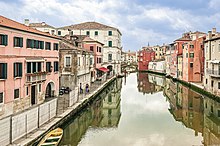Chioggia
Chioggia
Cióxa (Venetian) | |
|---|---|
| Città di Chioggia | |
 | |
 Chioggia within the Metropolitan City of Venice | |
UTC+2 (CEST) | |
| Postal code | 30015 |
| Dialing code | 041 |
| Patron saint | San Felice and San Fortunato |
| Saint day | June 11 |
| Website | Official website |





Chioggia (Italian:
Geography
The town is situated on a small island at the southern entrance to the
The municipality, located in south of the province, close to the provinces of Padua and Rovigo, borders with Campagna Lupia, Cavarzere, Codevigo, Cona, Correzzola, Loreo, Rosolina and Venice.
History
Chioggia and Sottomarina were not prominent in antiquity, although they are first mentioned in Pliny[5] as the fossa Clodia. Local legend attributes this name to its founding by a Clodius, but the origin of this belief is not known.
The name of the town has changed often, being Clodia, Cluza, Clugia, Chiozza, Chiozzo,
Culture
Until the 19th century, women in Chioggia wore an outfit based on an
.Chioggia served Carlo Goldoni as the setting of his play Le baruffe chiozzotte, one of the classics of Italian literature: a baruffa was a loud brawl, and chiozzotto (today more frequently chioggiotto in Italian, or cioxoto in Venetian) is the demonym for Chioggia. Goldoni took his setting seriously: the play is replete with lacemaking, fishermen, and other local color.
Main sights
Chioggia is often called "Little Venice", with a few canals, chief among them the Canale Vena, and the characteristic narrow streets known as calli. Chioggia has several medieval churches, much reworked in the period of its greatest prosperity in the 16th and 17th centuries.
The church dedicated to
The church of St. Andrew (18th century) has a bell tower from the 11th-12th centuries, the most ancient tower watch in the world. The interior has a Crucifixion by
Economy
Fishing is historically the livelihood of the port, and remains a significant economic sector. Other important modern industries include textiles, brick-making and steel; and Sottomarina, with 60 hotels and 17 campgrounds, is almost entirely given over to seafront tourism.
Demography

Traditions and folklore
During the third week end of June, the festival of Palio della Marciliana takes place.
Particularity of surnames
Chioggia represents an almost unique demographic case in Italy: the most common surname among the inhabitants of Chioggia is Zennaro, while the most common surnames of Sottomarina are Boscolo and Tiozzo.
Because of the large number of people with the same surname, the comune officialized what is known as "detto" (popular nicknames used to distinguish the various branches of the same family). These "third names" are inserted in every official document, including the driving license and the identity card.
Notable people
- Jacopo De Dondi (1290–1359), doctor, astronomer and clock-maker.
- Giovanni De Dondi (ca.1330 – 1388), an Italian physician, astronomer and mechanical engineer.
- Niccolò de' Conti (ca.1395–1469), an Italian merchant, explorer, and writer.[8]
- John Cabot (1450 – ca.1500), an Italian navigator and explorer.[9]
- Gioseffo Zarlino (1517–1590), Italian musical theorist.[10]
- Rosalba Carriera (1673–1757), a Venetian Rococo painter.
- Stefano Andrea Renier (1759–1830), an Italian naturalist, zoologist and scientist.
- Giuseppe Olivi (1769–1795), an Italian abbot and naturalist.
- Luigi Taccheo (1849–1940), an Italian pianist and composer.
- Aristide Cavallari (1849–1914), a Cardinal of the Roman Catholic Church and Patriarch of Venice.
- Giuseppe Veronese (1854–1917), an Italian mathematician.
- Eugenio Bonivento (1880–1956), an Italian painter.
- Lina Merlin (1887–1979), an Italian politician, promoted "Merlin law".
- Bruno Maderna (1920–1973), an Italian conductor and composer.
International relations
Twin towns — Sister cities
Chioggia is
 Lamia (Greece, 2007)
Lamia (Greece, 2007) Saint-Tropez (France, 2008)
Saint-Tropez (France, 2008)
Trivia
Chioggia gives its name to a variety of beetroot, radicchio (Italian chicory), and pumpkin (Marina di Chioggia).
See also
- A.C. Chioggia Sottomarina
References
- ^ Nowadays a quarter
- ^ "Superficie di Comuni Province e Regioni italiane al 9 ottobre 2011". Italian National Institute of Statistics. Retrieved 16 March 2019.
- ^ "Popolazione Residente al 1° Gennaio 2018". Italian National Institute of Statistics. Retrieved 16 March 2019.
- ^ Chisholm, Hugh, ed. (1911). . Encyclopædia Britannica. Vol. 6 (11th ed.). Cambridge University Press. pp. 235–236.
- ^ NH III.xvi.121
- ^ a b "Chiozzo", Encyclopaedia Britannica, vol. II (1st ed.), Edinburgh: Colin Macfarquhar, 1771.
- ^ History of Chioggia
- Beazley, Charles Raymond (1911). . Encyclopædia Britannica. Vol. 7 (11th ed.). pp. 28–29.
- ^ Biggar, Henry Percival (1911). . Encyclopædia Britannica. Vol. 4 (11th ed.). pp. 921–923.
- ^ . Encyclopædia Britannica. Vol. 28 (11th ed.). 1911. pp. 960–961.


